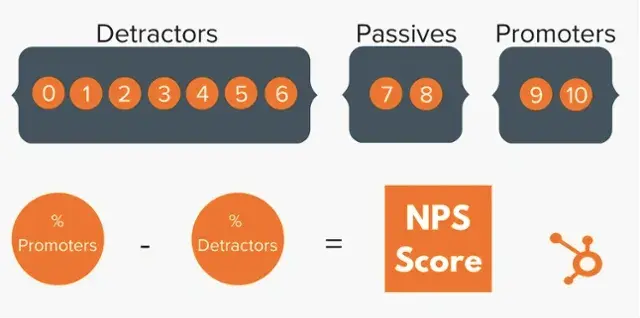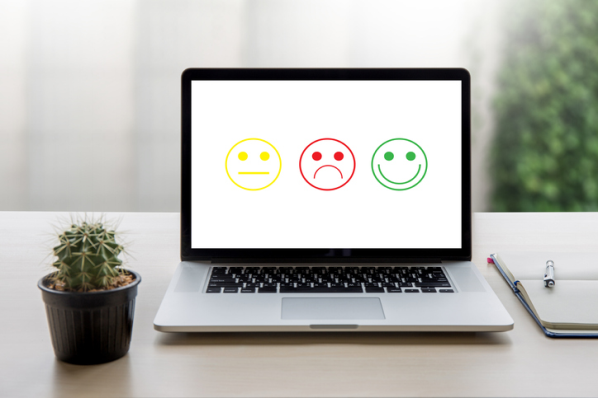By leveraging AI to prioritize NPS collection and analysis, companies can improve the experience for their customers without draining time or budget. I’ll share the types of NPS analysis, the reasons to conduct it (and why you should be using AI), and how to run an AI-powered NPS analysis.
Table of Contents
- Why Conduct an NPS Analysis?
- Types of NPS Analysis
- Can AI Help With NPS Analysis?
- How to Conduct an NPS Analysis Using AI
Here are three reasons why I think NPS is a great metric to analyze.
1. Increase customer retention.
NPS gives you an opportunity to address — and lower — churn rates. When you know why your customers are dissatisfied, it’s easier to make changes to keep future customers on the line. Not to mention, studies show that 70% of detractors will return if you fix a problem they’ve complained about.
NPS also gives you some insight on what makes customers loyal to your company. Analyzing positive feedback helps you understand what delights your customers so you can double-down on retention-increasing behaviors.
2. Drive business growth.
Promoters, by definition, are advocates for your brand. When you take time to learn about what makes a promoter at your company, you can expect growth by referral and advocacy. And you want referrals — people are four times more likely to purchase when a friend has referred them.
3. Benchmark against competitors.
NPS is a widely used metric on a global scale across industries. This makes it easy to benchmark your success against competitors. By comparing your NPS with industry standards, you can gauge how well you are doing in terms of customer satisfaction and loyalty, and predict your growth in comparison to your competitors.
Types of NPS Analysis
There are three main types of net promoter analysis: survey, sentiment, and score. To get the best use out of your NPS collection, I recommend analyzing your results using each of the three methods.
NPS Survey Analysis
The focus of survey analysis is about quantitative data. In a net promoter survey, customers respond to their experience with your organization on a scale of 0-10. They are generally answering the question, “How likely are you to recommend our product or service to a friend or colleague?”
The responses are then sorted into three categories:
- Promoters. Customers who marked a score of 9-10.
- Passives. Neutral customers who marked a score between 7-8.
- Detractors. Unhappy customers who marked a score of 6 or below.
Once you’ve received your survey responses, you can use this information to find average customer satisfaction. You can also relate the scores to other variables from your survey, like the product they ordered, their demographics, their time as a customer, and more.
NPS Sentiment Analysis
NPS surveys usually include opportunities for customers to leave written feedback. In sentiment analysis, you’ll also take a look at the qualitative feedback to identify key themes or topics mentioned. Sentiment analysis is a far more in-depth way of making sense of NPS surveys and, most often, you’ll need an AI tool to assist you.
Sentiment analysis is a type of text analysis that categorizes feedback from the comments and makes sense of the intention, or “sentiment,” of the customer. Some takeaways from sentiment analysis might include:
- A sentiment score that may or may not be the same as the NPS (for example, an individual may have a passive NPS but leave more negative comments, resulting in a lower sentiment score than NPS).
- Natural language processing, which highlights key emotional language from written feedback and provides more insight on the weight and connotation of comments.
- Thematic analysis, which looks at NPS feedback on an aggregated level and identifies key themes that appear repeatedly across customer responses.
Janet Gehrmann, the co-founder of Scoop Analytics, shed some light on the value of sentiment analysis.
“One of the advantages of AI is the sheer amount of data it can process, including sentiment data,” said Gehrmann. “I know several companies that have used different AI tools to analyze customer feedback sentiment and identify positive, neutral, and negative responses. It’s not only quicker than manual methods — it’s also more accurate.”
Net Promoter Score Analysis
The Net Promoter Score is a single quantitative measure that represents overall customer loyalty and satisfaction within your organization. Rather than averaging all the net promoter scores you collect, the final score is a result of subtracting the percentage of detractors from the percentage of promoters. This is the score you’ll use for competitive benchmarking.

Pro tip: HubSpot makes it easy to find your net promoter score with the Customer Service Metrics Calculator. This free Excel template helps you calculate your Customer Satisfaction Score (CSAT), Customer Lifetime Value (CLV), your NPS, and more.
Can AI Help With NPS Analysis?
Absolutely it can! AI can be used in quite a few different ways — to facilitate NPS collection, to analyze results, and to make recommendations. I’ll walk you through all the use cases.
- Create NPS surveys. You can use AI to help build NPS surveys from scratch. Lots of survey builders use AI to incorporate survey best practices into either templates or fully formed, complete surveys.
- Analyze data. Once you’ve received results back from your NPS surveys, AI tools can make sense of the data for you. Plug your survey data into an AI-augmented analytics tool and gather results about customer satisfaction trends. AI platforms like Momentum help companies automatically route survey feedback to account owners or customer success managers, shortening the loop between insight and action.
- Automate follow-ups. Once your customer has completed the NPS survey, you can use AI to automate follow-ups to thank them for their feedback and provide guidance for issues they raised in their survey.
- Make personalized recommendations. Your NPS tool can make recommendations to users based on their response. For example, if a customer responded with a glowing review and a high NPS score, AI may send them a recommendation for a product that the customer is likely to enjoy.
- Speed time to resolution. AI-powered virtual assistants can detect keywords in customer queries and route them to agents to handle their needs. In the case of feedback, you can easily adapt this tool to send negative surveys along to the right department who can respond.
Caleb Gonsalves, a customer success leader and consultant, leverages AI to send thoughtful follow-ups to customers who interact with his surveys.
“For anyone that responds to my survey, I always ensure they get a thank you tailored to the level of response,” he shared.
“If they’re a detractor, they’ll get personal outreach in an earnest attempt to document and remediate any issues they might be having. AI has dramatically improved the speed in which I can craft and tailor responses. It’s not a game changer per se (yet) but those incremental minutes sure do add up.”
How to Conduct an NPS Analysis Using AI
1. Choose the right AI NPS tool.
Before you can jump into your AI-powered NPS surveys, you’ll have to narrow down what you’re looking for in an NPS tool. I recommend defining what you need for the following qualities prior to shopping around for the right software:
- Capabilities. AI NPS tools can support users at a few parts of the survey journey. Some tools help to create the survey while others are focused on analysis. Even within analytics tools, there will be significant variation in capabilities, so be sure to outline what you’re looking for.
- Usability. As with any tool, you want to make sure the tool’s complexity matches the technological comfort of the team using it. If your data team is in charge of sending surveys along, they’re likely pretty comfortable with high-tech tools. But if your marketing team is in charge and less comfortable with AI, they may need a tool that prioritizes easy use.
- Reporting. To get the most use out of your net promoter surveys, you’ll want to turn the data into reports and visuals you can present to stakeholders in your organization. Some survey tools have lots of data visualization built in, while others are more limited in reporting features.
If you’re not sure what you’re looking for in a tool, I suggest leveraging a generative AI tool like ChatGPT to help you narrow down the right tool for your organization.
2. Create and send your survey.
To gather NPS scores, you’ll need a survey in place. Instead of wasting hours creating questions, selecting answer formats, and sending surveys by hand, you can use your AI tool to streamline the process.
HubSpot’s Customer Feedback Software can help you create the most effective NPS survey. Incorporate a variety of question types to measure multiple KPIs about customer experience. Then, send your survey via web link or email to start gathering your data.
3. Upload your data to the model.
In order to use AI to interpret your results, you’ll have to sync your survey results with the model. This can happen in real-time or after collection, depending on the survey tool you’re using and the analytics tool you’re integrating.
Your AI model may be built into your survey tool or it could be a separate software. If you are using different tools, I recommend you ensure your survey and analytics tools integrate with each other before you send out your surveys.
4. Calculate NPS.
Now that you have your data, start by calculating the net promoter score with the following formula:
NPS = % Promoters – % Detractors
This will give you the baseline to understand overall customer satisfaction. You can use this number for benchmarking against competitors or historical analysis of your own company’s performance.
5. Use AI for deeper analytics.
While the net promoter score gives some valuable insight on its own, I think the most effective way to take advantage of your NPS data is by using AI for deeper analytics. Use an AI model for:
- Predictive analysis. Predict future net promoter scores based on historical data.
- Text analysis. Process the scores and written feedback to identify specific customer sentiments and overarching themes in your survey results.
- Discover connections. Answer basic questions about NPS correlations. Are people in a specific sales region reporting a negative experience more often than others? Are there certain industries that are very satisfied and others that are not?
6. Visualize and report data.
Once you’ve done your analysis, you’ll want to convert the facts and figures into something that your team can make sense of. Use your AI tool’s dashboard to display NPS trends, sentiment distribution, and key topics discussed in feedback.
7. Act on the insights.
Use your analysis to identify pain points and present your findings to your team, highlighting what needs to change within your organization to improve overall customer satisfaction. For example, if one region is less satisfied than another, I might consider reallocating additional customer success team members to that region.
8. Continuously monitor.
In my experience, data is the most useful when you’re continuously monitoring it. I recommend paying attention to the impact of any changes that you’re making, asking, “What do the NPS scores look like over time and have the changes we’ve made had an impact?” Make sure to add your data into your AI models on a regular basis for the most accurate, updated output.
Takeaways
As a marketer, I’m still amazed at the way AI is integrating itself into my daily life. The availability of AI means that I can gain valuable, deep insights about an organization without having to spend days preparing surveys. I don’t need to be a survey expert and I don’t have to bring in data teams to make sense of the results. The tool does it for me.
But this doesn’t frighten me — I’m not worried about getting replaced or booted out because of a robot. AI tools can speed up so many parts of my job so I can get to the important work faster: improving the experience for my customers.
NPS
.png?width=112&height=112&name=Image%20Hackathon%20%E2%80%93%20Vertical%20(85).png)

.png)
![How I calculate net promoter score [formula & examples]](https://53.fs1.hubspotusercontent-na1.net/hubfs/53/%5BUse-Oct-14-2025-10-16-33-2257-PM.webp)


.jpg)




![NPS Question: The Secret to Getting It Right [+ 5 Best Practices]](https://53.fs1.hubspotusercontent-na1.net/hubfs/53/nps%20question_featured-1.jpg)
